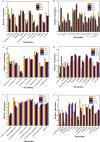Amphotericin B biosynthesis in Streptomyces nodosus: quantitative analysis of metabolism via LC-MS/MS based metabolomics for rational design
- PMID: 32005241
- PMCID: PMC6995120
- DOI: 10.1186/s12934-020-1290-y
Amphotericin B biosynthesis in Streptomyces nodosus: quantitative analysis of metabolism via LC-MS/MS based metabolomics for rational design
Abstract
Background: Amphotericin B (AmB) is widely used against fungal infection and produced mainly by Streptomyces nodosus. Various intracellular metabolites of S. nodosus were identified during AmB fermentation, and the key compounds that related to the cell growth and biosynthesis of AmB were analyzed by principal component analysis (PCA) and partial least squares (PLS).
Results: Rational design that based on the results of metabolomics was employed to improve the AmB productivity of Streptomyces nodosus, including the overexpression of genes involved in oxygen-taking, precursor-acquiring and product-exporting. The AmB yield of modified strain S. nodosus VMR4A was 6.58 g/L, which was increased significantly in comparison with that of strain S. nodosus ZJB2016050 (5.16 g/L). This was the highest yield of AmB reported so far, and meanwhile, the amount of by-product amphotericin A (AmA) was decreased by 45%. Moreover, the fermentation time of strain S. nodosus VMR4A was shortened by 24 h compared with that of strain. The results indicated that strain S. nodosus VMR4A was an excellent candidate for the industrial production of AmB because of its high production yield, low by-product content and the fast cell growth.
Conclusions: This study would lay the foundation for improving the AmB productivity through metabolomics analysis and overexpression of key enzymes.
Keywords: Amphotericin B; Metabolomics; Overexpression; Streptomyces nodosus.
Conflict of interest statement
The authors declare that they have no competing interests.
Figures





Similar articles
-
Comparative metabolomics analysis of amphotericin B high-yield mechanism for metabolic engineering.Microb Cell Fact. 2021 Mar 9;20(1):66. doi: 10.1186/s12934-021-01552-z. Microb Cell Fact. 2021. PMID: 33750383 Free PMC article.
-
Enhancing the production of amphotericin B by Strepyomyces nodosus in a 50-ton bioreactor based on comparative genomic analysis.3 Biotech. 2021 Jun;11(6):299. doi: 10.1007/s13205-021-02844-2. Epub 2021 May 27. 3 Biotech. 2021. PMID: 34194892 Free PMC article.
-
Enhanced amphotericin B production by genetically engineered Streptomyces nodosus.Microbiol Res. 2021 Jan;242:126623. doi: 10.1016/j.micres.2020.126623. Epub 2020 Oct 13. Microbiol Res. 2021. PMID: 33189073
-
Amphotericin B: an update.Br J Biomed Sci. 1996 Jun;53(2):122-33. Br J Biomed Sci. 1996. PMID: 8757689 Review.
-
Amphotericin-B colloidal dispersion. A review of its use against systemic fungal infections and visceral leishmaniasis.Drugs. 1998 Sep;56(3):365-83. doi: 10.2165/00003495-199856030-00008. Drugs. 1998. PMID: 9777313 Review.
Cited by
-
Comparative metabolomics analysis of amphotericin B high-yield mechanism for metabolic engineering.Microb Cell Fact. 2021 Mar 9;20(1):66. doi: 10.1186/s12934-021-01552-z. Microb Cell Fact. 2021. PMID: 33750383 Free PMC article.
-
Enhancing the production of amphotericin B by Strepyomyces nodosus in a 50-ton bioreactor based on comparative genomic analysis.3 Biotech. 2021 Jun;11(6):299. doi: 10.1007/s13205-021-02844-2. Epub 2021 May 27. 3 Biotech. 2021. PMID: 34194892 Free PMC article.
-
Enhanced AmB Production in Streptomyces nodosus by Fermentation Regulation and Rational Combined Feeding Strategy.Front Bioeng Biotechnol. 2020 Jul 15;8:597. doi: 10.3389/fbioe.2020.00597. eCollection 2020. Front Bioeng Biotechnol. 2020. PMID: 32760700 Free PMC article.
-
Untargeted MS-Based Metabolomic Analysis of Termite Gut-Associated Streptomycetes with Antifungal Activity against Pyrrhoderma noxium.Antibiotics (Basel). 2023 Aug 28;12(9):1373. doi: 10.3390/antibiotics12091373. Antibiotics (Basel). 2023. PMID: 37760670 Free PMC article.
-
Synthetic biology approaches to actinomycete strain improvement.FEMS Microbiol Lett. 2021 Jun 11;368(10):fnab060. doi: 10.1093/femsle/fnab060. FEMS Microbiol Lett. 2021. PMID: 34057181 Free PMC article. Review.
References
MeSH terms
Substances
Supplementary concepts
Grants and funding
LinkOut - more resources
Full Text Sources

